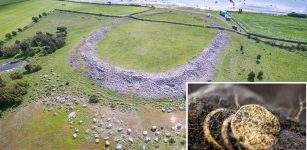Nomadic Pasture Farming Was Developed 7,000 Years Ago In Swiss Alps
AncientPages.com - People in Switzerland were running high alpine pastures much earlier than previously assumed, according to a study that combines archeological knowledge with findings from paleoecology.

The hunter of Schnidi - a prehistoric model displayed at the Bern Historical Museum three years ago
(Keystone/Archäologischer Dienst Kanton Bern)
Scientists from the Oeschger Centre for Climate Change Research at Bern University say there’s a chain of evidence supporting a theory that shepherds living in southwestern Switzerland around 5,000 BC drove their herds to pastures situated at around 2,750 meters above sea level in the Alps.
“We have strong indications that argue that people were on the move in the mountains with their animals much earlier than previously assumed,” study author Albert Hafner said.

Fragments of a prehistoric shoe found near the Schnidejoch Pass
(Keystone/Archäologischer Dienst Kanton Bern)
He said the combination of two scientific approaches allowed the scientists to collect better data and interpret it with a new perspective, according to a press release by Bern University.
According to the study, early alpine farmers in the region of lower Valais and the Bernese Oberland kept sheep and goats. The dry and steep slopes of the Valais did not produce much feed, which is why the shepherds undertook a two-day hike to the Schnidejoch Pass to find good grazing opportunities.
This nomadic pasture farming was only possible as the glaciers drastically retreated during the so- called Holocene Climatic Optimum period.
The scientists say a melting ice field on the Schnidejoch Pass has exposed several hundreds of prehistoric objects since 2003.
Strong indication of very early pastoralism in the area is mainly provided by the reconstruction of the region’s vegetation history.
The paper was published in an article in the Quaternary International specialist journal.
AncientPages.com




















